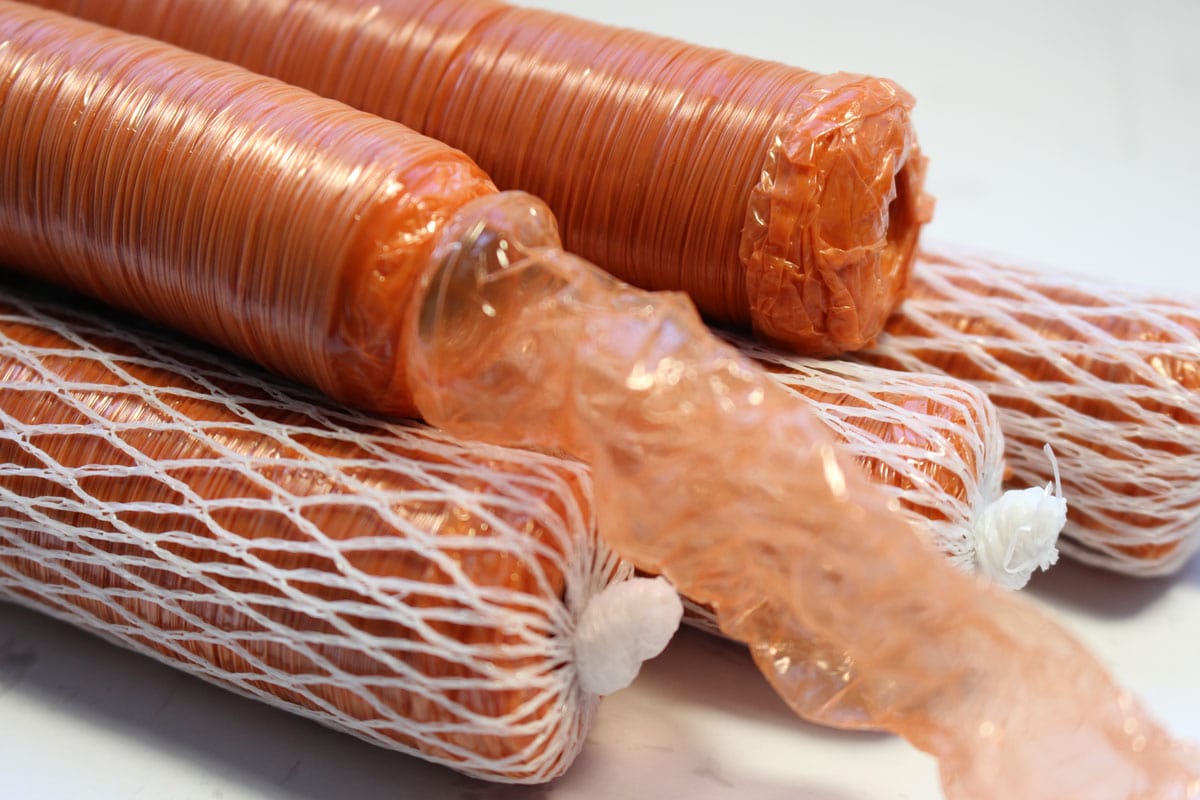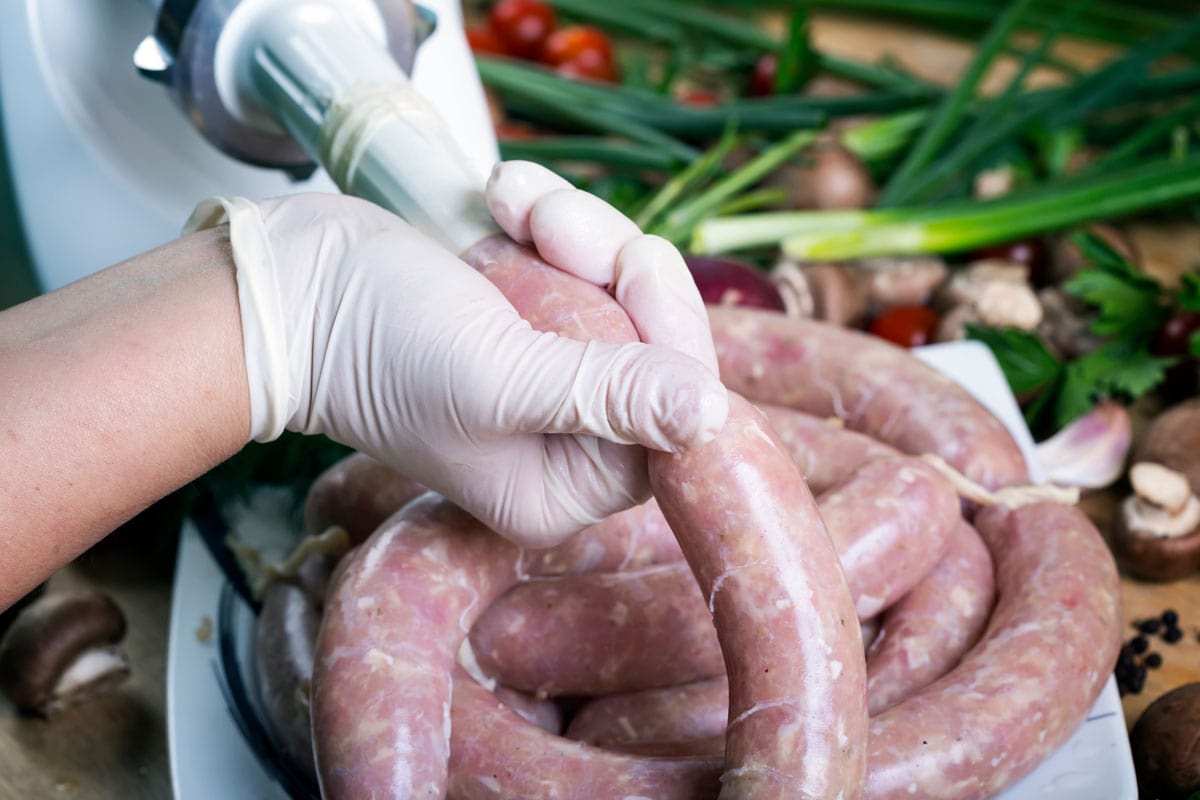Sausage casings are an essential part of the sausage-making process. But what causes sausage casings to become tough? Is there a way to fix this issue? Let's take a look below.
Sausage casings can be tough due to the following reasons:
- Not cleaned properly
- Casings weren't pierced
- Old casings
- Not brought to room temperature
- Freezing casings
- Under or overstuffed casings
- Overcooked
To prevent tough sausage casings, it's important to follow these steps:
- Flush casings with water and vinegar.
- Bring sausage casings to room temperature.
- Stuff the sausage casings so they are tight.
- Pierce the casing prior to cooking.
- Don't overcook.
By understanding how to prepare and cook sausage casings properly, you can help ensure that the end product is tender and delicious. In this article, we will discuss why your sausage casings are tough and how to avoid this issue in the future. In addition, we will answer other frequently asked questions about making sausage, so read on!
Why Are My Sausage Casings Tough?
Sausage casings are the intestines of animals that have been cleaned and trimmed for use in making sausage. They come in a variety of sizes and can be made from different types of animals, including pork, beef, lamb, or venison.
Casings are an essential part of the sausage-making process, as they provide a way to contain the meat mixture and prevent it from falling apart. For those who like to make homemade sausage, the casings are usually one of the first steps in the process.
Many times, when sausage casings come out tough after cooking, this can result in an unenjoyable texture and taste. There are a few common causes for tough sausage casings and how to avoid them.

Not Cleaned Properly
Before using your sausage casings, it's important to make sure they have been thoroughly cleaned. Sausage casings contain salt when they are purchased, and if they aren't cleaned properly, this salt can be left behind. The salt can cause your casings to dry out and become tough.
To combat this, soak your casings in warm water and vinegar. This will help to break down the salt residue and ensure that your sausage casings are clean. Depending on the type of casing, let them soak for an hour to 24 hours.
Once the casings have been soaked, it's time to clean them with water. Using your fingers, open the casings and flush out any remaining bits of salt or dirt. Repeat this process until the casings are completely clean.
Casings Weren't Pierced
Making a few small holes in your sausage casings can help prevent them from becoming tough. Before cooking, use a small fork or skewer to make some holes in the casing.
If you don't, air pressure can build up inside the casing as it cooks and cause it to become tough. The holes will allow steam to escape, ensuring that your sausage casings stay tender.
Old Casings
Over time, sausage casings can become dried out and tough. Be sure to inspect your casings before using them, as old casings may not be suitable for cooking.
While casings have a long shelf life, they can become brittle with age. If you notice any signs of discoloration or cracking, it's best to discard the casings and buy new ones.
Freezing Casings
It's vital to never freeze your sausage casings. Freezing them can cause the casings to become tough and difficult to use.
Instead, leave your casings in their original packaging and place them in the fridge until you are ready to use them. When properly stored, they can last for 1-2 years.

Under Or Overstuffed Casings
Another common issue is that casings are either under or over-stuffed. If the casing is too full, it can cause the casing to become tough when cooked.
On the other hand, if the casings are loosely filled, too much air can get trapped inside and cause the casing to dry out. To prevent this, find a happy medium by filling the casings just enough to make sure they are tightly packed.
Not Brought To Room Temperature
A common mistake many people make is not allowing their casings to come to room temperature before cooking. Cold casings can cause the meat mixture to clump together and become tough.
To prevent this from happening, remove your sausage casings from the refrigerator an hour or two before cooking. This will help ensure that the casings are soft and pliable when cooking.
Overcooked
Cooking your sausage too long can result in tough casings. As the heat continues to circulate, it will draw all of the moisture out and make them chewy and dry. To avoid this, use a thermometer to check on the internal temperature of your sausages.
One of the best ways to cook fresh sausage is to simmer it in a pan of water. This will help keep the casings from drying out and becoming tough. Put the sausage in cold water and then bring it to a simmer.
Typically, this will take 6-12 minutes or until the internal temperature of the sausage reaches 165°F. Once it has reached this temperature, remove the sausages from the heat and let them rest for 5 minutes before serving.
If you choose to cook your fresh sausage on the grill, keep an eye on it to make sure the casings don't overcook. Cook them over indirect heat, or you can choose to wrap them in foil to ensure they stay moist and tender.
By following these tips, you should be able to successfully make delicious sausages that have tender casings. With a little bit of patience and knowledge, you can easily make sausages that are enjoyable to eat.

What Are The Most Tender Sausage Casings?
If you are looking for the most tender sausage casings, sheep casings are the way to go. They are naturally thinner and more delicate than pork or beef casings, making them ideal for cooking.
Sheep casings also have a mild flavor that won't overpower your sausages. Although they may be more expensive than other types of casing, they are definitely worth the cost due to their unique texture and taste.
In addition, sheep casings absorb fat better than other types of sausage casings, resulting in a juicy and tender bite every time. You can use sheep casings to make smaller sausages, like hot dogs and chorizo, or breakfast sausages.
Is Making Homemade Sausage Worth It?
While making homemade sausage can be a rewarding experience, it does take some time and effort. You need to carefully prepare the meat mixture, stuff it into the casings, and then cook it properly.
It's also important to keep in mind that not every sausage you make will turn out perfect. Even if you do everything right, there can still be things that go wrong.
If you're willing to put in the effort and don't mind making mistakes along the way, then making your own sausage is definitely worth it. Not only will you be able to control the ingredients but also create sausages that are unique and delicious.
Plus, you may save money in the long run since you won't have to buy pre-made sausages from the store. If you want to have fun on the weekend, give homemade sausage making a try. It's an enjoyable and rewarding experience!

How Can You Tell If Sausage Casings Are Bad?
As mentioned earlier, sausage casings have a long shelf life when properly stored. However, if you have had them for a while or if they've been exposed to high temperatures, it's best to check before using them.
To tell if your sausage casings have gone bad, look for discoloration or any signs of mold. Also, the casings should feel soft and pliable when touched, not hard or brittle.
In addition, if the casings are noticeably slimy or have an unpleasant smell, then they should be discarded.
Finally, if the casings have any holes or tears, then they are no longer suitable for use and should be thrown away. It's always best to err on the side of caution when it comes to food safety, so don't take any risks with bad sausage casings.
How Long Does It Take To Make Homemade Sausage?
![Raw stuffed sausages in cookware on a wooden, What Causes Tough Sausage Casings? [& Possible Fixes]](https://kitchenseer.com/wp-content/uploads/2022/12/111What-Causes-Tough-Sausage-Casings-Possible-Fixes.png)
Depending on the type of sausage you are making, the time it takes to make homemade sausages can vary. For small-batch sausages like chorizo or breakfast links, it should take roughly an hour or two from start to finish.
For larger batches, such as Italian sausages or bratwurst, you may need up to four hours of active preparation time. This includes grinding and seasoning the meat, prepping the casings, stuffing the casings, and then cooking them.
So if you want to make delicious homemade sausages, set aside some time in your schedule to allow for the entire process. While it can be time consuming, the results will be well worth it!
Final Thoughts

Without the sausage casings, it would be almost impossible to make homemade sausages. By taking the time to prepare the right type of casing, you can ensure that your sausages are juicy, tender, and full of flavor. With some trial and error, you'll be able to make sausages that taste great every time.
Made it to the end? Here are other articles you might find helpful:
Is Kielbasa & Sausage The Same Thing – What Is The Difference?
What Meat Grinder Plate Sizes Should I Have [Inc. Size For Hamburger, Sausage, & More]?






